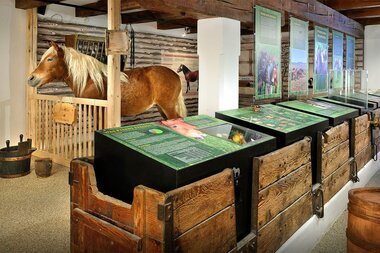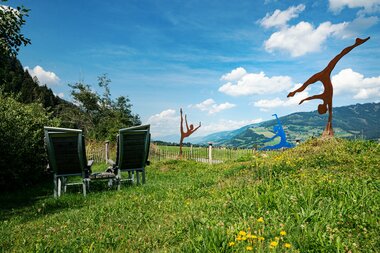Mountains full of history and legend
The Isonta meandered unhandled in a valley, which was covered with high reeds - a primeval landscape. Around 2,100 years ago, this was the habitat of the Ambisonten: "Those who lived by the Isonta (Salzach) - the river and this Celtic tribe were called. The valley floor, with its many boggy places, was uninhabitable, so the people lived in small wooden houses on the mountain. The Naglköpfl was perfectly situated: From there, they could strategically overlook the whole valley.

She has emerald-green eyes, long hair and, like a druid, wears a wonderful embroidered dress and precious jewellery: our Celtic fairy "Isonta". The first rays of sunlight dye the Naglköpfl in a soft light and the last patches of fog rise from the valley. She relaxes on a wooden lounger and drinks her beloved goat's milk from a beautifully decorated clay bowl from Venice. Due to beauty, she dabs the last drops on her cheeks and forehead.
She wants to gather flowers to wrap around her Tauerngold ball. She ties the flower together with a piece of wool. In this way she is betting on a good harvest, for today the moon and the stars are in a favourable constellation. She begins to gather roots and herbs that she needs for healing ...
The ways of the Ambisonen, which took them across the Alps as far as Venice, were used for the exchange of goods and even for some luxury items. The days were full of movement, mainly in search of food, such as hunting, farming and cultivating the primeval landscape.
From that time until today, 70 generations have worked on what we love today: Even high up on the wonderful alpine pastures, everything is well kept in all directions. Additionally in the core area of the Hohe Tauern National Park, nature itself is the director.
Our Celtic fairy "Isonta" in the logo of Piesendorf Niedernsill is a tribute to this time.
Piesendorf

Piesendorf was first documented in 1147 as "Puesendorf". The name is derived from the Romanesque priest Boso. The first settlements around the Naglköpfl are known from around 1500 bC. Friedrich von Walchen, who was also Archbishop of Salzburg, played an important role in the first documented mention.
The Chinese Town

Sebastian Perfeller, an adventurer and fantasist who had never been to China in his life, fulfilled a dream: starting around 1867, he built a town in the Chinese architectural style near his parents' home in Fürth (a district of Piesendorf), complete with filigree turrets, countless staircases and much more.
Murals in St Michael's Chapel

During the restoration of the parish church of Piesendorf, an art-historical sensation was discovered in the attached chapel of St Michael: A mural of magnificent and priceless beauty. The painted inscription is clearly readable as the name "Michael", the year is recognisable as 143 (?). The paintings are surrounded by decorative stenciled frames.
Celtic power place at Naglköpfl
Here at the Naglköpfl, sherd finds and superficial rough excavations indicate that there must have been miners' settlement here as early as the late Bronze Age (Urnfield Period) and early Hallstatt Period, and that copper was mined here.

As archaeological excavations in Uttendorf (within sight) have uncovered stone box graves from the Hallstatt period, it is like that traces can also be found here. In any case, there is much to suggest this:
-
The unobstructed view of the valley in all directions.
-
The strategic location: the terrain slopes steeply to the south and west.
-
The flat, gently sloping terrain to the north was probably used for agriculture and livestock and was not visible from the valley.
-
And the protective wall to the east, still clearly visible today.
A real reconstruction of the settlement and the burials would only be possible through archaeological excavations, using new technologies such as aerial archaeology, laser scanning, geomagnetics and geoelectrics.
Today, the Naglköpfl is a magical place of power that invites you to relax and recharge your batteries.
Kunstweg - certified themed hiking trail
The certified "Kunstweg" art trail features three works by renowned Berlin artists.
The circular walk starts at the hiking info point and leads past the Hinkelsteinbad in the direction of Hummersdorf to the first art station "Schlangenbaum" artwork. Continue to the "Kopfsteher" artwork and then turn left along the Salzach river to the Krinner bridge, where the "Salzachtanz" artwork with the Tauern loungers awaits you. Relax and walk along the Tauern Cycle path to the "Piesendorfer Grundzusammenlegung" artwork and back to your starting point.
Granite boulder on the Rohrerberg
About 115,000 years ago, the last glacial period in the Earth's history began. Over tens of thousands of years, glaciers from the north and the Alps advanced, retreated and expanded again. In the process, the mighty ice streams carved out valleys such as the Salzach valley, carrying hugh amounts of rock, fine sediments and boulders weighing thousands of tonnes.
Traces of the glacial period are still visible in many landscapes. The alpine glaciers advanced furthest about 25,000 years ago. In Germany the glaciers reached almost as far as Munich, in Switzerland as far as Berg, Zurich and in the Lake Constance region as far as Schaffhausen. Some glaciers even reached their maximum after the peak of the last glacial period. The researchers found that this was the case in the Salzach valley around 21,000 years ago.
This granite boulder, weighing about 25 tonnes and located at an altitude of about 1,350 metres above sea level, was transported northwards from the Uttendorf Stubach valley to Piesendorfer Hochsonnberg (Rohrerberg / Walchen district).
Niedernsill

In 963 the district of Lengdorf (Lengindorf) is mentioned in a document. In the 12th century, the Niedernsill properties appear in deeds of transfer as the property of St Peter of Salzburg.
The name Niedernsill is derived from Nidrinseli, which is made up of the original Nidrin meaning "lowest" and seli meaning "settlement". Niedernsill has been documented since about 1140.
Noriker horse Museum

Noriker through the ages - An exhibition about horses and people in the Hohe Tauern National Park
The Noriker - a horse with history! The name Noriker comes from the Roman province of Noricum. The breed has undergone many changes and is now bred in five bloodlines. This breed of horse is particularly suitable as a carriage, riding and pack horse. In the exhibition the horse is shown in all its activities, movements and behaviour with the help of the latest technology.
Tauriska Dialect Archive

The Tauriska Dialect Archive contains older and contemporary dialect literature of the region in the form of books and manuscripts. These include dictionaries from 1785 onwards, as well as old sayings, games, songs and stories. There are also radio plays and videocassettes with recordings of life in the region, as well as works by regional dialect writers.





